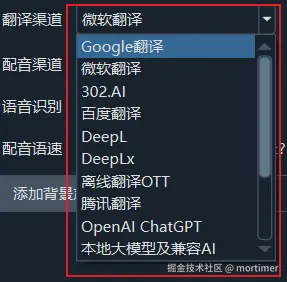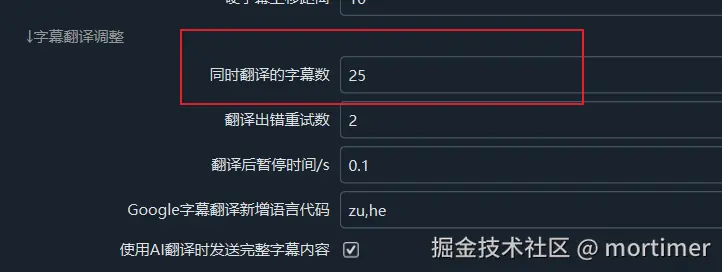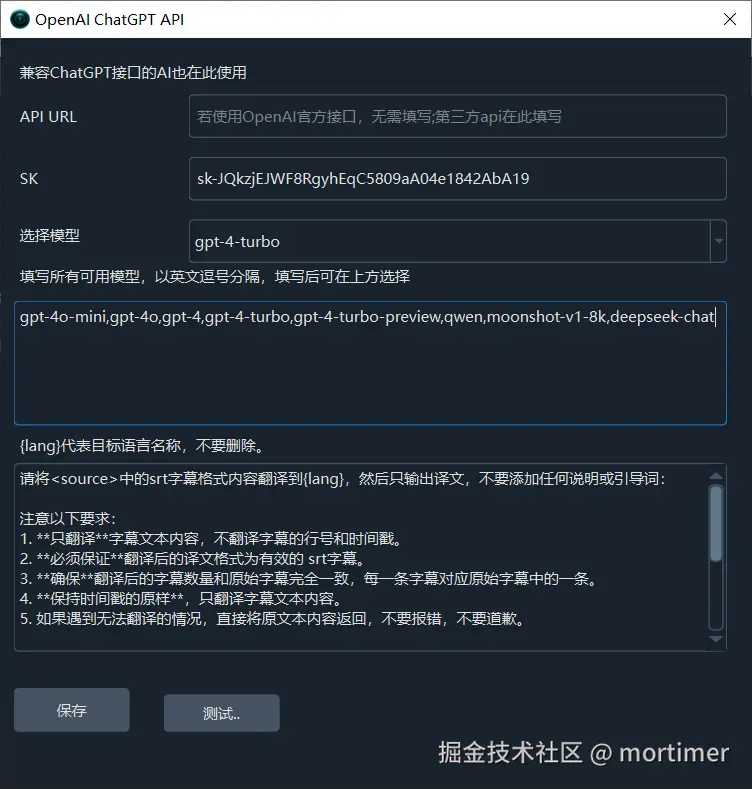Subtitles generated from audio or video recognition are translated into the target language via a translation channel, then used for dubbing. Clearly, the translation quality directly affects the dubbing outcome.

Translation channels can be categorized into traditional and AI translation:
- Traditional Translation: Google Translate, Microsoft Translator, DeepL, Baidu Translate, Tencent Translate
- AI Translation: ChatGPT, Gemini, AzureGPT, 302.ai, various domestic AI models, local large models
By pricing
- Free without limits: Google, Microsoft
- Free with quotas: Baidu Translate, Tencent Translate, various domestic AI models, Gemini
- Paid: DeepL, ChatGPT, AzureGPT, Gemini
By proxy requirement
- Requires proxy: Google, ChatGPT, Gemini
- No proxy needed: Domestic translation services, DeepL
Software supports two translation methods
- Submit only the plain text from subtitles to the translation channel, replacing the original text with the translation result.
All traditional translation channels (except Google) use this method.
- Pros: Ensures the translation result is in valid SRT subtitle format; saves on character count.
- Cons: If the translated text doesn't match the original line count, it may force line-by-line translation, losing context and resulting in poor quality.
With this method, excessive blank lines may appear. Without line numbers, it's impossible to identify which line is blank, so they are placed at the end, potentially causing subtitle disorder. Thus, when blank lines occur, the system forces re-translation line by line, losing contextual relevance.
- Submit the complete SRT subtitle format to the translation channel, including line numbers, timestamps, and other non-translatable content.
- Pros: Better contextual relevance, reduces excessive blank lines.
- Cons: Wastes tokens; less intelligent AI might return incorrect SRT formats, such as merging line numbers with the next line or converting English punctuation in timestamps to Chinese, leading to invalid SRT and parsing errors.
This method may still return blank lines, but it doesn't affect the outcome because blank lines retain valid line numbers and timestamps, as the translation result is merged with the previous line for semantic coherence, especially when the line contains only one or two isolated words.
By default, AI translation and Google use this method. To switch to the first method, uncheck Menu > Tools/Options > Advanced Options > Subtitle Translation > Send full subtitle content for AI translation.

Number of subtitles translated at once

In Menu > Tools/Options > Advanced Options > Subtitle Translation > Number of subtitles translated simultaneously, you can set how many subtitles to translate in a batch. A higher number speeds up translation and improves contextual relevance, but too high may exceed character limits and increase blank lines.
Summary: Choosing a Translation Channel
For completely free and unlimited use: First choice is
Google(requires proxy), second isMicrosoft Translator.For completely free with frequency/ quota limits: First choice is domestic AI providers like
deepseek.com,kimi.moonshot.cn,302.ai, etc., followed by Tencent Translate, Baidu Translate, Gemini (requires proxy).Without a proxy: First choice is domestic AI providers, then
Microsoft Translator,Tencent Translate,Baidu Translate, etc.For the best quality: First choice is
OpenAI ChatGPT; if no paid account, use third-party API relays like 302.ai. Second isGemini(requires proxy), then domestic AI providers.Not recommended: DeepLx, which essentially uses free DeepL traffic illegally. Due to high subtitle counts and frequent requests, local deployment can quickly get IP blocked by DeepL and become unusable.
Not recommended: Local large model translation, limited by computing resources. Locally deployed models are usually smaller and less intelligent, often resulting in messy translation formats. If insisted upon, uncheck Menu > Tools/Options > Advanced Options > Subtitle Translation > Send full subtitle content for AI translation and set Number of subtitles translated simultaneously to 5 or less.
For extreme cases where only one line is translated at a time to ensure 100% format accuracy with no blank lines, set Menu > Tools/Options > Advanced Options > Subtitle Translation > Number of subtitles translated simultaneously to 1. Sacrifices quality for perfect format.
How to use domestic AI providers in the software
Ensure the provider's API is compatible with OpenAI. Copy the provider's API address, SK key, and model name. Open the software and go to Translation Settings > OpenAI ChatGPT and Compatible APIs.

Fill in the API URL with the provider's specified address, enter the SK key, and type the model name in the large text box. Then select it from the "Select Model" dropdown. Test to confirm it works and save.

